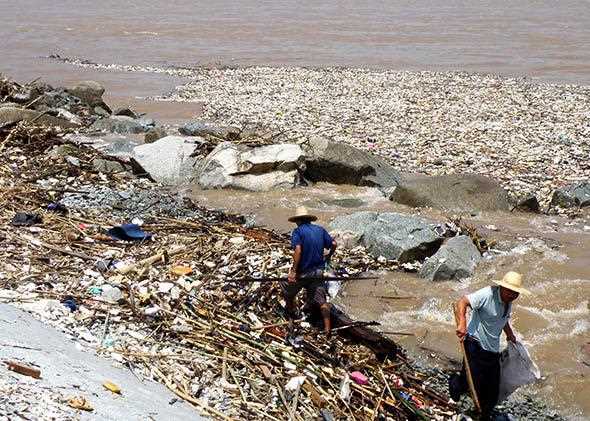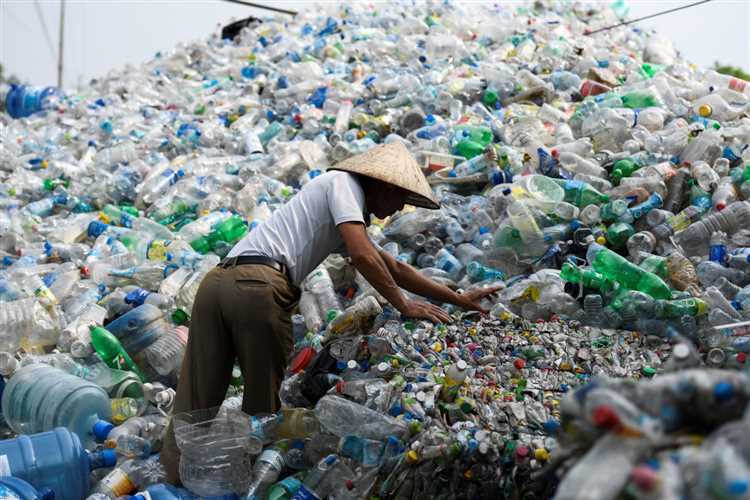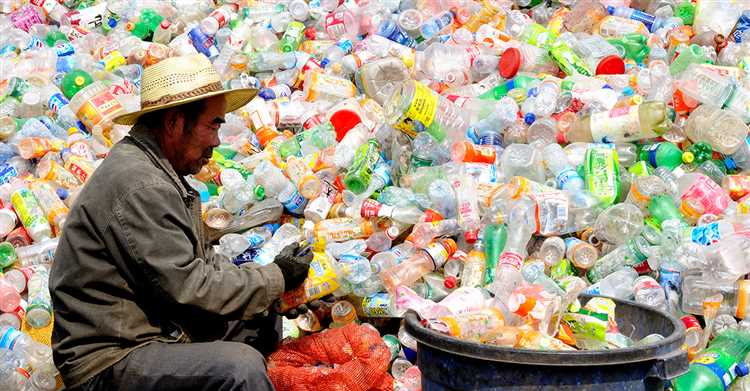
China, with its massive population and rapid industrialization, faces significant challenges in managing its waste. The country generates an enormous amount of garbage each year, and finding sustainable ways to dispose of it has become a pressing issue. With its booming economy and ever-increasing urbanization, China has had to come up with innovative solutions to tackle this problem.
One of the main strategies employed by China in waste management is recycling. The government has implemented strict recycling policies and invested heavily in recycling infrastructure. These efforts have paid off, with China becoming one of the world’s largest recyclers of paper, plastic, and metal. Recycling not only helps reduce the volume of waste going to landfills but also contributes to the conservation of natural resources.
Another approach China has taken is waste-to-energy conversion. With limited landfill space available, the country has turned to facilities that convert waste into energy. These facilities use advanced technologies to incinerate waste and generate electricity or heat. Waste-to-energy plants not only help reduce the need for traditional fossil fuel-based energy sources but also minimize the environmental impact of waste disposal.
- The Challenges of Waste Management in China
- 1. Urbanization and Population Growth
- 2. Illegal Dumping and Improper Disposal
- 3. Recycling and Resource Recovery
- 4. E-waste and Hazardous Waste
- The Current State of Waste Disposal in China
- Landfill Site Management and Challenges
- Incineration as a Solution
- China’s Efforts in Recycling and Waste Reduction
- National Recycling Programs
- Waste Segregation and Sorting
- Investing in Waste-to-Energy Technology
- Public Awareness and Education
- Technological Innovations in Waste Management
- The Role of Robotics in Waste Management
- The Importance of Public Awareness and Education
- International Collaboration in Tackling China’s Waste Management Issues
- Questions and answers:
- What is the current waste management situation in China?
- How does China dispose of its garbage?
- What challenges does China face in waste management?
- What measures has the Chinese government taken to improve waste management?
- What are the environmental impacts of China’s waste management practices?
The Challenges of Waste Management in China
China, with its rapidly growing population and booming economy, faces significant challenges in waste management. The country produces an enormous amount of waste each year, making it crucial to develop effective and sustainable waste management strategies.
1. Urbanization and Population Growth

One of the major challenges in waste management in China is the rapid urbanization and population growth. As more people migrate from rural areas to urban centers, the amount of waste generated significantly increases. The lack of proper waste management infrastructure in these areas poses a significant challenge in efficiently collecting, sorting, and disposing of waste.
2. Illegal Dumping and Improper Disposal
Illegal dumping and improper disposal of waste are common problems in China. Due to inadequate enforcement of waste management regulations and lack of awareness among the public, many individuals and businesses resort to illegal dumping of waste. This not only harms the environment but also contributes to the spread of diseases and pollution.
3. Recycling and Resource Recovery
China’s waste management system faces challenges in terms of recycling and resource recovery. While the country has made efforts to improve recycling rates, there are still significant barriers to effective recycling. These include the lack of proper infrastructure and technology, inadequate collection and separation practices, and limited market demand for recycled materials.
4. E-waste and Hazardous Waste
Another major challenge in waste management in China is the handling of e-waste and hazardous waste. With the rapid growth of the electronics industry, there has been an increase in the generation of electronic waste. Currently, China is the largest producer of e-waste globally. Proper disposal and recycling of hazardous waste are also crucial to prevent environmental contamination and health risks.
- Improving waste management infrastructure and facilities.
- Strengthening enforcement of waste management regulations.
- Increasing public awareness and education on proper waste disposal practices.
- Encouraging sustainable waste management practices through incentives and policies.
- Investing in research and development of innovative waste management technologies.
Addressing these challenges requires a comprehensive and multi-faceted approach to waste management in China. By implementing sustainable waste management strategies, such as recycling, resource recovery, and proper disposal, China can mitigate the environmental and health impacts of waste and contribute to a more sustainable future.
The Current State of Waste Disposal in China

In recent years, China has been facing a significant challenge in waste management due to its rapid economic growth and urbanization. As the world’s largest population, China generates massive amounts of waste on a daily basis, making waste disposal a pressing issue for the government and Chinese citizens.
One of the primary methods of waste disposal in China is landfilling. Landfills are designated areas where solid waste is dumped and buried. However, the excessive amount of waste being produced has led to a scarcity of land for landfill sites. Moreover, the improper management of landfills has resulted in environmental pollution, including soil and water contamination.
To address these challenges, the Chinese government has implemented various policies and initiatives to improve waste disposal practices. One such initiative is the promotion of waste incineration. Incineration involves burning waste at high temperatures to reduce its volume and generate energy. This method not only helps in waste reduction but also provides an alternative source of energy.
Despite the benefits of incineration, this method is not without challenges. The process can release harmful pollutants and toxins into the air if not adequately controlled. To mitigate these risks, China has implemented strict emission standards and invested in advanced technologies, such as flue gas treatment systems, to minimize air pollution from incineration plants.
Another approach to waste disposal in China is recycling. The government has encouraged the public to separate recyclable materials and introduced recycling programs in many cities. However, the effectiveness of recycling in China remains a challenge due to insufficient infrastructure and a lack of public awareness. There is a need for more investment in recycling facilities and education campaigns to promote recycling habits among Chinese citizens.
In recent years, China has also explored innovative waste management solutions, such as anaerobic digestion, which involves converting organic waste into biogas. This process not only reduces waste but also produces renewable energy and organic fertilizers. Anaerobic digestion has shown potential as a sustainable waste disposal method and has been implemented in various parts of China.
In conclusion, waste disposal is a pressing issue in China due to its population size and rapid economic growth. The government has implemented various strategies, including landfilling, incineration, recycling, and anaerobic digestion, to address the problem. However, further efforts are needed to improve waste management infrastructure, promote recycling habits, and ensure the proper treatment of waste to minimize environmental impact.
Landfill Site Management and Challenges
The management of landfill sites in China is a challenging task due to various factors. Firstly, the sheer volume of waste generated by the country’s large population poses a significant challenge. China is the world’s largest producer of solid waste, and finding suitable land for landfill sites is becoming increasingly difficult.
Another challenge is the lack of proper waste segregation practices. Many landfill sites in China receive mixed waste, which includes both hazardous and non-hazardous materials. This makes it difficult to handle and dispose of waste properly, as different types of waste require different treatment methods.
Additionally, the pollution caused by landfill sites is a major concern. Landfills produce harmful gases such as methane, a powerful greenhouse gas that contributes to climate change. China has been working to mitigate these environmental impacts by implementing measures such as gas capture systems to collect and utilize methane for energy generation.
Furthermore, the management of landfill sites involves the monitoring and control of leachate, the liquid that seeps out from decomposing waste. If not properly managed, leachate can contaminate groundwater and soil, posing a risk to human health and the environment.
To address these challenges, the Chinese government has been actively promoting waste reduction and recycling initiatives. The implementation of stricter waste management regulations and the development of advanced landfill technologies have also been key strategies in improving landfill site management.
Overall, the management of landfill sites in China is a complex task that requires comprehensive waste management strategies and effective implementation of regulations and technologies. With continued efforts and investments in waste management, China aims to improve the efficiency and sustainability of landfill site operations while minimizing the environmental impacts.
Incineration as a Solution
The rapid economic growth and urbanization in China have led to a significant increase in waste generation. As a result, the country has been exploring various ways to address its waste management challenges. One of the solutions that China has implemented is incineration.
Incineration involves the combustion of waste materials, which helps reduce the volume of waste and generate energy. China has been investing heavily in building incineration plants across the country to effectively manage its waste.
Incineration has several advantages. Firstly, it helps reduce the volume of waste, which is crucial in a country with limited landfill space. By burning the waste, China can free up valuable land resources for other purposes. Additionally, incineration generates energy through the combustion process. This energy can be harnessed and used for various purposes, including electricity generation.
Furthermore, China has implemented strict regulations and emission control measures to ensure that incineration does not harm the environment. Advanced technologies and equipment, such as advanced flue gas cleaning systems, are used to minimize air pollution and remove harmful substances from the emissions.
Although incineration has its benefits, it is not without challenges. The public’s perception of incineration as a polluting and unhealthy method of waste disposal has been a major hurdle in its widespread acceptance. To address this concern, China has been actively engaging with the public, conducting awareness campaigns, and implementing measures to improve transparency and accountability in the incineration process.
In conclusion, incineration is one of the solutions China has adopted to address its waste management challenges. It helps reduce waste volume, generate energy, and minimize environmental impacts. With continued efforts to improve public perception and strengthen regulations, incineration can play a significant role in China’s waste management system.
China’s Efforts in Recycling and Waste Reduction
China has recognized the importance of recycling and waste reduction in managing its garbage problem. The country has implemented several strategies and initiatives to promote recycling and reduce waste generation.
National Recycling Programs
China has established national recycling programs to encourage the collection and recycling of various materials. One notable program is the “National Sword” policy, which aims to restrict the import of foreign waste and promote domestic recycling. This policy has led to improved waste sorting and recycling practices within the country.
Waste Segregation and Sorting
China has made efforts to promote waste segregation and sorting at the source. Many cities have implemented separate collection systems for different types of waste, such as paper, plastics, and organic waste. Residential communities and commercial entities are required to sort their waste before disposal, helping to facilitate recycling and reduce landfill space.
Investing in Waste-to-Energy Technology

In addition to recycling, China has invested in waste-to-energy technology to convert waste into energy. This approach helps to reduce the volume of waste going to landfills and provides a renewable energy source. Waste incineration plants equipped with state-of-the-art technology have been built across the country, making use of the energy content in municipal waste.
Public Awareness and Education
China recognizes the importance of public awareness and education in achieving effective waste management. The government has launched campaigns to educate the public about waste reduction, recycling, and responsible waste disposal practices. The efforts aim to change public perceptions and behaviors towards waste, encouraging individuals to participate in recycling programs and adopt sustainable waste management habits.
In conclusion, China’s efforts in recycling and waste reduction are crucial in managing its waste problem. By implementing national programs, promoting waste segregation, investing in waste-to-energy technology, and raising public awareness, China is taking significant steps towards a more sustainable approach to waste management.
Technological Innovations in Waste Management
China has been at the forefront of technological innovations in waste management, constantly exploring new ways to improve efficiency, reduce environmental impact, and promote sustainable practices. These innovations have helped the country tackle its growing waste problem and pave the way for a more sustainable future.
One of the key technological innovations in waste management is the adoption of smart waste management systems. These systems utilize sensors and Internet of Things (IoT) technology to monitor the fill levels of waste bins in real-time. This allows for optimized waste collection routes, reducing fuel consumption and emissions. It also ensures timely waste collection, preventing overflow and unsightly waste accumulation.
Another area of innovation is waste-to-energy technology. China has invested heavily in building waste-to-energy plants, which convert municipal solid waste into energy through various processes such as incineration and anaerobic digestion. This not only reduces the amount of waste going to landfill but also generates electricity and heat, contributing to the country’s renewable energy goals.
Additionally, China has embraced the use of big data and artificial intelligence (AI) in waste management. Big data analytics enables authorities to gather, analyze, and interpret vast amounts of data to identify waste generation patterns, optimize waste collection routes, and forecast waste management needs. AI-powered sorting systems are also used in recycling facilities to increase the efficiency and accuracy of waste sorting, leading to higher recycling rates.
The Role of Robotics in Waste Management
Robotics is another field of technological innovation that is transforming waste management in China. Robotic systems are being developed and deployed for various tasks, such as autonomous waste collection and automated sorting in recycling facilities. These robots are equipped with advanced sensors and cameras, allowing them to identify and handle different types of waste materials with precision and efficiency.
The use of robotics not only improves the speed and accuracy of waste collection and sorting but also reduces the reliance on human labor, which can be both costly and potentially hazardous. Furthermore, robots can operate efficiently in hazardous or challenging environments, such as landfills or contaminated sites, minimizing risks to human workers.
The Importance of Public Awareness and Education
While technological innovations play a crucial role in waste management, it is equally important to raise public awareness and promote education about waste reduction and recycling. China has implemented educational campaigns and initiatives to educate citizens about the importance of responsible waste disposal and encourage recycling practices.
By combining technological advancements with public awareness and education, China is taking significant steps towards more sustainable waste management practices. These innovations not only benefit China but also serve as valuable lessons and inspiration for other countries facing similar waste management challenges.
| Technological Innovations in Waste Management |
|---|
| Smart waste management systems |
| Waste-to-energy technology |
| Big data and artificial intelligence (AI) in waste management |
| Robotics in waste collection and sorting |
| Public awareness and education |
International Collaboration in Tackling China’s Waste Management Issues
China’s waste management challenges are not confined to its borders; they have global implications. Recognizing this, various international organizations and countries have been collaborating with China to address its waste management issues.
One prominent example of international collaboration is the partnership between China and the United Nations Environment Programme (UNEP). The UNEP has been working closely with China to develop and implement sustainable waste management practices. Through joint initiatives, such as capacity building programs and knowledge sharing, both parties are striving to improve waste management efficiency and reduce the environmental impact.
In addition to the UNEP, other international organizations, such as the World Bank, have also been engaging with China on waste management issues. The World Bank has provided financial support and technical expertise to help China implement sustainable waste management strategies. This collaboration has resulted in the construction of modern waste treatment facilities and the establishment of effective waste collection and disposal systems.
Furthermore, several countries have entered into partnerships with China to exchange best practices and knowledge in waste management. For example, countries like Germany and Japan, known for their advanced waste management systems, have been sharing their experiences and technologies with China. This collaboration has allowed China to learn from the successes of these countries and apply their strategies in its own waste management practices.
The benefits of international collaboration in tackling China’s waste management issues are twofold. Firstly, it enhances China’s capacity to effectively manage its waste by leveraging the expertise and resources of other countries and organizations. Secondly, it promotes global environmental sustainability by addressing the transboundary effects of China’s waste management practices.
| International Collaboration Partners | Activities |
|---|---|
| United Nations Environment Programme (UNEP) | – Capacity building programs – Knowledge sharing – Implementation of sustainable waste management practices |
| World Bank | – Financial support – Technical expertise – Construction of modern waste treatment facilities |
| Germany and Japan | – Sharing best practices and technologies |
In conclusion, international collaboration plays a crucial role in tackling China’s waste management challenges. Through partnerships with organizations like the UNEP, the World Bank, and countries like Germany and Japan, China is receiving valuable support and knowledge to implement sustainable waste management practices. This collaboration not only benefits China but also contributes to global environmental sustainability.
Questions and answers:
What is the current waste management situation in China?
China faces a massive waste management challenge. With its population of over 1.4 billion, the country generates a staggering amount of garbage each day. In recent years, the Chinese government has been implementing various strategies to address this issue and improve waste management practices.
How does China dispose of its garbage?
China employs several methods for disposing of its garbage. These include landfilling, incineration, and recycling. Landfilling is the most common method, but the government is gradually reducing its reliance on landfills and promoting more sustainable waste management techniques, such as incineration and recycling.
What challenges does China face in waste management?
China faces several challenges in waste management. One of the main challenges is the sheer volume of waste generated due to its large population. Another challenge is the proper segregation of waste, as many people in China continue to dispose of their garbage improperly. Additionally, the country’s aging landfill infrastructure and limited recycling facilities pose significant challenges in effectively managing waste.
What measures has the Chinese government taken to improve waste management?
The Chinese government has implemented several measures to improve waste management. These include stricter regulations on waste disposal, the construction of waste-to-energy plants for incineration, and the promotion of recycling initiatives. The government is also investing in research and development of innovative waste management technologies to address the growing waste problem.
What are the environmental impacts of China’s waste management practices?
China’s waste management practices have significant environmental impacts. Improper waste disposal, such as landfilling, can lead to groundwater and soil contamination. Incineration, while providing energy, can release harmful pollutants into the air. The lack of proper recycling infrastructure results in valuable resources going to waste. These environmental impacts highlight the urgent need for improved waste management practices in China.